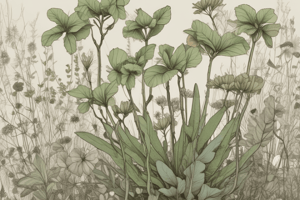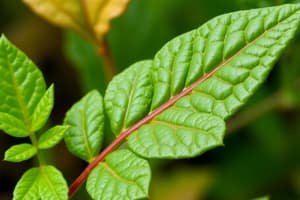Podcast
Questions and Answers
Which of the following is NOT a characteristic of plant cells?
Which of the following is NOT a characteristic of plant cells?
- Presence of a cell wall made primarily of cellulose
- Presence of a nucleus
- Presence of a rigid exoskeleton (correct)
- Presence of chloroplasts for photosynthesis
What is the primary function of leaves in a plant?
What is the primary function of leaves in a plant?
- Support and transport of water and nutrients
- Photosynthesis, converting light energy into chemical energy (correct)
- Protection of seeds
- Absorption of water and nutrients from the soil
Which of the following is an example of asexual reproduction in plants?
Which of the following is an example of asexual reproduction in plants?
- Pollination of a flower by a bee
- Growth of a new plant from a cutting of the parent plant (correct)
- Spore formation in ferns
- Fusion of gametes in flowering plants
Which group of plants includes conifers such as pine trees?
Which group of plants includes conifers such as pine trees?
Which of the following is NOT a role played by plants in terrestrial ecosystems?
Which of the following is NOT a role played by plants in terrestrial ecosystems?
What is the primary mechanism by which plants obtain water and nutrients?
What is the primary mechanism by which plants obtain water and nutrients?
Which of the following is NOT a characteristic of flowering plants (Angiosperms)?
Which of the following is NOT a characteristic of flowering plants (Angiosperms)?
What is the main difference between sexual and asexual reproduction in plants?
What is the main difference between sexual and asexual reproduction in plants?
What is the primary function of photosynthesis in plants?
What is the primary function of photosynthesis in plants?
Which of the following processes is NOT directly involved in plant physiology?
Which of the following processes is NOT directly involved in plant physiology?
What role do plant hormones play in plant growth?
What role do plant hormones play in plant growth?
How do plants contribute to maintaining ecosystem health?
How do plants contribute to maintaining ecosystem health?
What is the economic importance of plants in the textile industry?
What is the economic importance of plants in the textile industry?
Flashcards
Plant Physiology
Plant Physiology
The study of biochemical and physiological processes in plants.
Photosynthesis
Photosynthesis
Process by which plants convert light energy into chemical energy stored in sugars.
Transpiration
Transpiration
The loss of water vapor from plant leaves.
Nutrient Uptake
Nutrient Uptake
Signup and view all the flashcards
Economic Importance of Plants
Economic Importance of Plants
Signup and view all the flashcards
Botany
Botany
Signup and view all the flashcards
Plant Structure
Plant Structure
Signup and view all the flashcards
Plant Reproduction
Plant Reproduction
Signup and view all the flashcards
Bryophytes
Bryophytes
Signup and view all the flashcards
Pteridophytes
Pteridophytes
Signup and view all the flashcards
Gymnosperms
Gymnosperms
Signup and view all the flashcards
Angiosperms
Angiosperms
Signup and view all the flashcards
Study Notes
Introduction to Botany
- Botany is the scientific study of plant life, encompassing their structure, function, growth, reproduction, and distribution.
- It explores various aspects of plant biology, from the microscopic level of cells to the macroscopic level of ecosystems.
- Plant life forms a critical component of the global ecosystem, providing oxygen, food, and shelter for a vast array of organisms.
Plant Structure and Function
- Plants are eukaryotic organisms, characterized by cell walls composed primarily of cellulose.
- They exhibit a variety of structures, including roots, stems, leaves, flowers, and fruits, each with specific functions.
- Roots absorb water and nutrients from the soil.
- Stems support the plant and transport water and nutrients throughout the plant body.
- Leaves are responsible for photosynthesis, using sunlight to convert carbon dioxide and water into energy.
- Flowers are specialized structures for sexual reproduction, typically containing both male and female reproductive organs.
- Fruits develop from the ovary of the flower and protect the seeds.
- Different plant species exhibit adaptations tailored to their specific environments.
Plant Reproduction
- Plants can reproduce both sexually and asexually.
- Sexual reproduction involves the fusion of gametes (specialized cells) from two parent plants.
- Examples of sexual reproduction include pollination in flowering plants and spore formation in non-flowering plants.
- Asexual reproduction involves the creation of new plants from vegetative parts of the parent plant.
- Methods include cuttings, runners, and tubers.
- The various reproductive strategies ensure the continuation of plant species across diverse environments.
Plant Diversity
- Plants are classified into different groups, reflecting their evolutionary relationships and unique characteristics.
- Major groups include Bryophytes (mosses and liverworts), Pteridophytes (ferns), Gymnosperms (conifers), and Angiosperms (flowering plants).
- Each group possesses specific adaptations to varying environments.
Plant Ecology
- Plants play a crucial role in terrestrial ecosystems.
- They are the primary producers, forming the base of the food web.
- Plants interact with other organisms, including animals, fungi, and bacteria, through complex ecological relationships.
- Examples include symbiotic relationships, competition for resources, and predator-prey interactions.
- Understanding plant ecology is fundamental to comprehending the interconnectedness of living organisms within their environment and how various factors influence plant growth.
Plant Physiology
- Plant physiology investigates the biochemical and physiological processes within plants.
- Key processes include photosynthesis, respiration, transpiration, hormone regulation, and nutrient uptake.
- Photosynthesis converts light energy into chemical energy stored in sugars.
- Respiration releases energy from sugars for cellular activities.
- Transpiration is the loss of water vapor from leaves.
- Plant hormones regulate various physiological processes and growth patterns.
- Nutrient uptake from the soil is essential for plant growth and development.
Economic Importance of Plants
- Plants are economically crucial for human needs.
- Food production relies heavily on crops like wheat, rice, maize, and various fruits and vegetables.
- Plants provide raw materials for textiles, paper, and building materials.
- Many medicines and pharmaceuticals are derived from plant extracts.
- Plants play a vital role in maintaining ecosystem health.
Studying That Suits You
Use AI to generate personalized quizzes and flashcards to suit your learning preferences.




